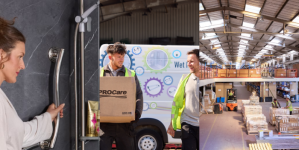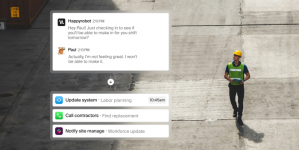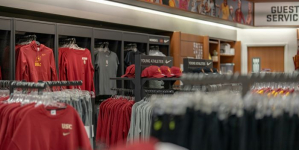-
AI startup Onton raises $7.5M to reinvent the way the world discovers and decides what to buy - November 26, 2025
-
Forklift Market Positions for Recovery as Confidence Expected to Build from 2026 - November 26, 2025
-
PROCare achieves 300% order capacity increase and 99% picking accuracy with Forterro’s ERP solution, Orderwise - November 26, 2025
-
DHL boosts operational efficiency and customer communications with HappyRobot’s AI Agents - November 25, 2025
-
STENA LINE TEAMS UP WITH CAMERA TELEMATICS TO DRIVE SAFETY IMPROVEMENTS AT IRISH SEA PORTS - November 25, 2025
-
Another design award for Toyota’s lithium-ion Traigo_i counterbalanced forklift - November 21, 2025
-
Stuut Technologies Raises $29.5 Million Series A Led by Andreessen Horowitz to Automate Accounts Receivable Work - November 20, 2025
-
INCREASED DIGITAL INVESTMENT REQUIRED TO KEEP PACE WITH 2026 CUSTOMS CHANGES - November 19, 2025
-
FULFILMENT SOLUTIONS FOR SPORTS MERCHANDISE: KEEPING OUR EYE ON THE GAME - November 19, 2025
-
COMPLEX, COSTLY & CONFUSING – THE END OF DE MINIMIS - November 19, 2025
AR Offers a Better Solution for Seasonal Surge.
By Brian Ballard, Co-founder and CEO, Upskill
If the holiday shopping boom is make-or-break for retailers, it’s do-or-die for the fulfillment partners responsible for making sure all those gift orders are packed, shipped and delivered on time.
Warehouses and logistics companies will, on average, double their workforce for peak 60 days leading up to the holidays, adding a slew of seasonal workers who need to get up to speed on the intricacies of modern warehousing practices, then execute quickly and accurately during the most intense stretch of business of the year. For example, behemoth Amazon says it will add 120,000 workers this holiday season, while Target plans to hire 100,000 seasonal workers, including 4,500 at its distribution and fulfillment centers.
It isn’t any surprise then that 63 percent of industry leaders surveyed in a recent Deloitte study on behalf of the Materials Handling Institute (MHI) say hiring and training a skilled workforce is their top challenge, compared to 55 percent who cite customer demand for faster response times and 53 percent for lower costs.
Promising technologies like robotics, automation, advanced IT solutions and IoT may pay off in the long run, but materials handling still depends on people to drive productivity in core labor-intensive processes. Fortunately, there’s an innovative technology that can help address the immediate needs of the logistics industry, including the challenge of integrating a large number of less-skilled, less-trained seasonal workers at the most important time of the year.
Augmented Reality (AR) delivered via smart glasses provides access to visual information, real-time updates, documents, human expertise, enterprise systems and step-by-step guidance, smoothing the integration between people, data and machines in the smart, connected warehouse. Here’s how it can help supply chain and warehouse managers address the specific challenges of variable demand and the seasonal workforce.
Where AR Fits Within the Warehouse
There are many versions of AR, ranging from head-mounted displays to immersive systems that overlay digital data on top of objects and locations in the physical world. But even at its most basic level, AR solves an important problem in the warehouse: providing hands-free connectivity and data access to workers on the move.
Devices like tablets and smartphones solve the mobility issue, but still require workers to look at the screen and manipulate the interface. Voice-based solutions deliver real-time data, but are not as rich or intuitive as visual interfaces. They can also be complicated to implement when the workforce is multilingual or has uneven levels of English language comprehension, as is often the case with seasonal, temporary warehouse staff.
Smart glasses take those benefits a step further by making it seamless for hands-on workers to access information, communicate and share real-time video with colleagues, interact with and display valuable data in real-time, and even record and document step-by-step processes and order completions using simplified gestures and voice commands.
“Within the four walls of operations, distribution centers across the board are adopting technologies that provide visual information to workers within current processes,” says Ron Kubera, Executive Vice President and Chief Marketing Officer at Lucas Systems in the MHI report. “I think adoption of smart glasses is going to accelerate over the next 18 to 24 months because of the visual component they offer alongside other hands-free technologies, especially multi-lingual voice-direction and speech recognition.”
Employee training and knowledge transfer
One of the biggest challenges in bringing on seasonal staff is getting new hires up to peak levels of productivity as fast as possible. In a given 90-day peak period, time spent training and upskilling temporary employees to necessary levels is usually done in under two weeks. This involves classroom training, e-learning and a certain amount of on-the-job experience before the worker can quickly and reliably complete a complex task or adhere to standard procedures.
Even proper training in structured processes does not always account for the dynamic variability in many warehouse environments. Workers not only have to get up to speed on specific tasks, but must quickly embrace the flexibility needed to deal with changes in pacing and procedure in real-time as orders come in.
AR provides several solutions for this. Training manuals and other printed materials can be made available digitally, where workers can access them as needed on their smart glasses. The same goes for recorded videos and other visual materials like maps and graphics. In many cases, tasks can be broken down into a series of discrete steps and relayed to the worker in real-time, as they are working. This not only avoids the need for significant training before moving workers into production environments, but it also simplifies the process and promotes better retention of information, because the trainee is actually doing the task as they are learning it. In addition, providing this information and instruction in a visual form via smart glasses makes it easier to be understood by workers irrespective of language or literacy.
“In our research, we’ve found that companies are able to get new or temporary workers up to speed much faster by using these devices,” said Dr. Randy Bradley, Assistant Professor of Information Systems and Supply Chain Management at the University of Tennessee’s Haslam College of Business.
Communication and collaboration systems can also be deployed to smart glasses, allowing workers to instantly connect to colleagues and supervisors with questions, including the ability to hold an object up to the camera and confirm whether it is correct. Workers can initiate video calls to supervisors to escalate and resolve issues immediately; supervisors can check in with individual workers or broadcast video-conferences to teams on the floor using the same technology.
These capabilities can also address issues of knowledge transfer. Experienced, full-time staff can record videos documenting their informal knowledge, making it easier for new and temporary workers to embrace best practices that are not documented or included in formal training. As employers build a repository of these ad-hoc tips and tricks, they can be made searchable and incorporated into formal training and documentation later.
Common worker tasks and processes
Moving from training into what is actually happening with the warehouse, AR can increase the accuracy and auditability of a range of different standard tasks and processes from loading and unloading, and receiving to picking and kitting, cycle counting, and shipping.
Loading and Unloading, Receiving and Shipping. In loading and unloading, and receiving, workers wearing smart glasses can use AR to digitally check boxes and pallets off a manifest as they are moved around the dock and warehouse, and note any damage or disparities in the system, along with a photo, video or other record of the problem for future auditability. Outbound items can be sorted and checked out as they are shipped so customers and managers can have deeper visibility into shipping status.
Picking, Packing and Kitting. As new orders come in, pickers can be updated in real time, through their smart glasses and immediately directed to the aisle, section and bin for where to find and pick items. Providing this information visually and in context right within their line-of-sight enables for faster location and item recognition, and selection.
For kitting, AR can be used to present workers with a visual diagram of a kit as they are performing the kitting task, reducing likelihood of error and making it easier for the workers to keep their eyes on their work, rather than glancing over at an instruction sheet or handheld device.
Cycle Counting. Cycle counting can be a rather manual and tedious task in a warehouse, but necessary for effective inventory auditing. Using AR, warehouse management can improve the speed and efficiency of these operational processes, while also better utilizing their staff during idle times. Using AR, employees can receive new task notifications during downtimes and then be guided through all the steps in how to handle a cycle-count, regardless of whether he or she had been trained on the task previously. As the worker identifies exceptions during the audit, he or she can capture the anomaly using the smart glasses and then send images to the existing systems in the warehouse for documentation.
Return Processing and Quality Control. AR can also improve the common warehouse task of handling merchandise returns. As workers are handling return processing, they can compare returned products against the original order so they can match items properly, check for damage and mark returns as complete.
Dr. John Peck, President and CEO of FastFetch Corp, believes that smart glasses could play an even bigger role in quality control.
“Smart glasses, particularly those combined with a speech recognition component, would allow a quality inspector to verbally describe what they are seeing—problematic or not—as well as visually compare and measure an item against a representative sample image,” he suggests.
Integrating AR with Scanners
Choosing AR platforms that can integrate with existing supply chain and warehouse systems and connected tools, such as wearable and handheld scanners (laser 1D, 2D, and RFID), is an important factor also for consideration, as there are number of tasks throughout the warehouse that require scanning as part of the materials handling process. One option is to use the built-in camera within smart glasses to handle scanning. Alternatively, organizations can integrate smart glasses with wrist or finger worn scanners.
Which method is best often will come down to ergonomics and the material handling setting. Laser- and RFID-based scanning techniques tend to be more reliable and can be used universally in any conditions and materials handling environments, but come at an additional cost to the AR solution. Camera-based scanning on smart glasses adds little to no incremental cost, but is limited by the fact that barcodes must be “visible” to the onboard computer vision algorithm. This is a function of the distance between the head-worn camera on the smart glasses and the barcode, size, type and lighting conditions.
AR in Broader Technology Context
There are an assortment of technologies with the potential to disrupt the supply chain and logistics industry in the coming decade. Industry executives surveyed by Deloitte rated robotics and automation as having the highest potential for disruption or competitive advantage, followed by predictive analytics, IoT, autonomous vehicles and sensors. The survey also noted an uptick in investments in technology since 2015 as industry players move past the initial barriers to adoption.
Among the biggest stumbling blocks, according to the report, is the skills gap. More technology means a more complex workplace, which will make it even more difficult for some employers to prepare their seasonal workforce for the holiday crunch or other peak times throughout the year.
AR can mitigate some of those issues as well. All the training, just-in-time information delivery, collaboration and knowledge transfer capabilities described above can reduce training requirements and help get temporary workers more comfortable using advanced technology and equipment. Using powerful AR platforms also integrate information and data from sensors, equipment and enterprise systems to workers in the context of their workflow, so they are connected to the processes that surround them.
Effective integration of people and equipment is even more relevant in specialized kinds of warehousing such as cold storage or other kinds of perishable or volatile inventory. The more advanced equipment and data permeates the environment, the more human workers in the warehouse need insight into real-time data streams and direct, instantaneous contact with managers to report and resolve irregularities.
With the right technologies in place, a warehouse worker could see the real-time data output of a machine behind them, the status and capacity of robots in the vicinity, or the travel paths of driverless forklifts through the warehouse in a heads-up display. Greater connection between people and machines not only promotes higher productivity, it also makes for a safer workplace.
In these scenarios, AR solutions connected to ERP systems can also support regulatory compliance, risk management and forensic data requirements, adding to the data record and providing evidence to identify points of failure.
Empowering people to meet rising expectations
People remain a critical component in the logistics process, even as automation increases. The holiday season surge will continue to call for tens of thousands of temporary, inexperienced workers into the warehouse, where they will be expected to perform at the highest levels with very limited time for training and acculturation. Other spikes in demand related to predictable events (the Super Bowl, turn of a new season, etc.) or unforeseen circumstances (surprising new trends and consumer fads, natural disasters, regional activities) may put pressure on suppliers year-round to grow their workforce overnight, with even less warning. With this kind of variability, warehouses need solutions that can be both flexible and scalable.
AR isn’t the only solution to this challenge, but it is part of the toolkit that logistics and supply chain leaders should consider as they move toward their visions of the Warehouse of the Future. It’s also not a process that should be implemented overnight. We recommend identifying one key use case to begin with, taking a baseline productivity measurement, employing the AR solution on a phased, and assessing the impact on a discrete set of tasks. That can provide the ROI case for deployment at scale quickly thereafter.

































